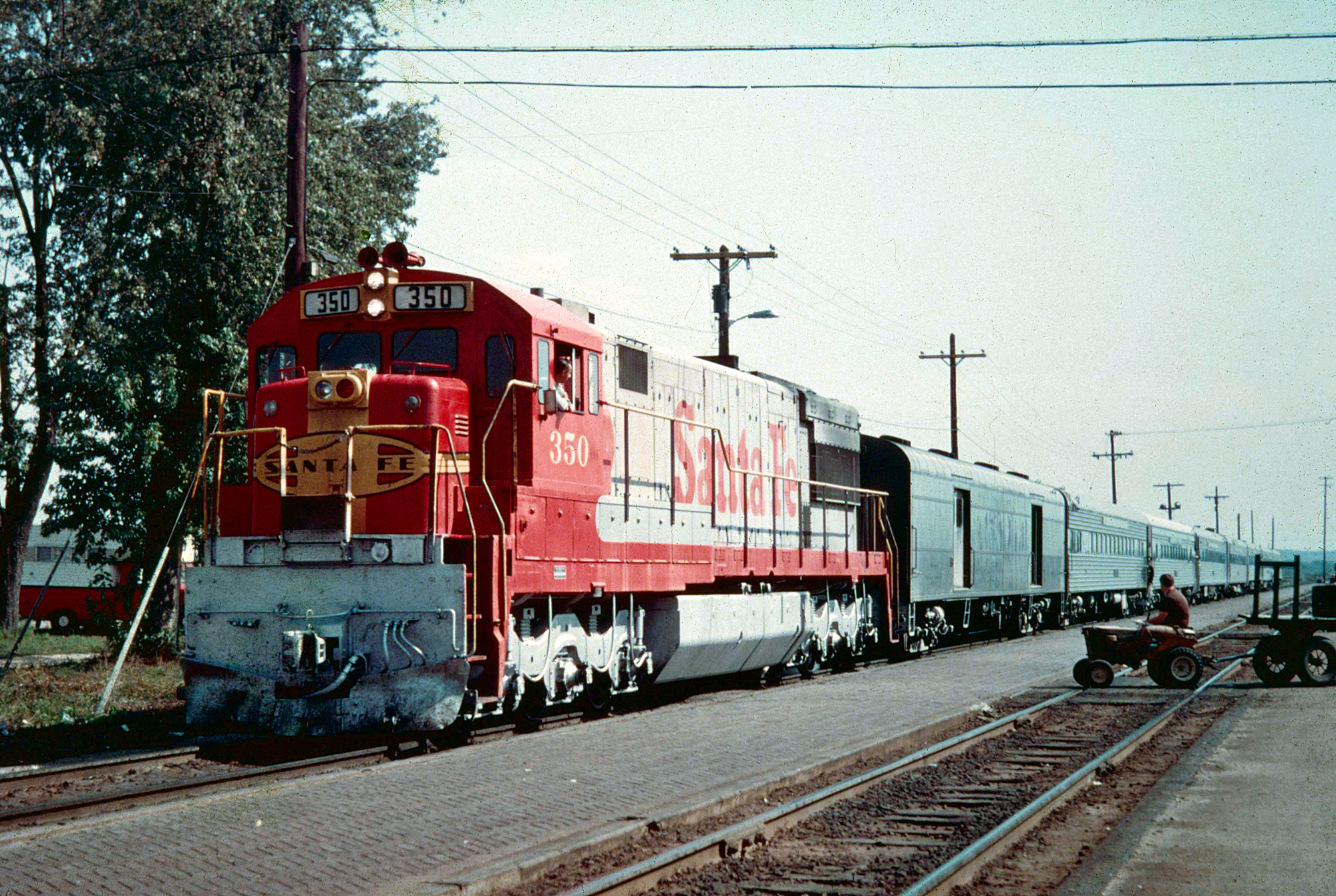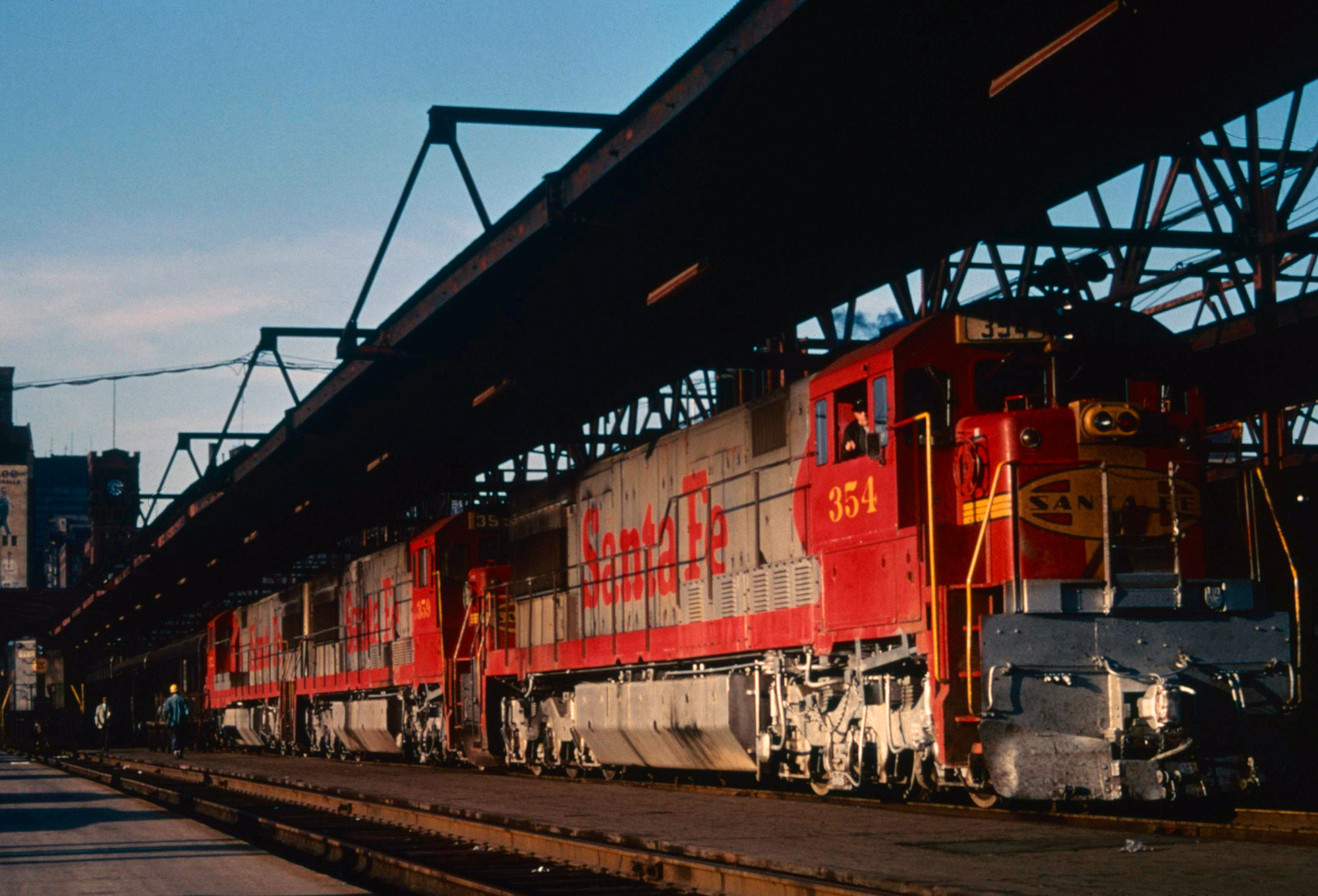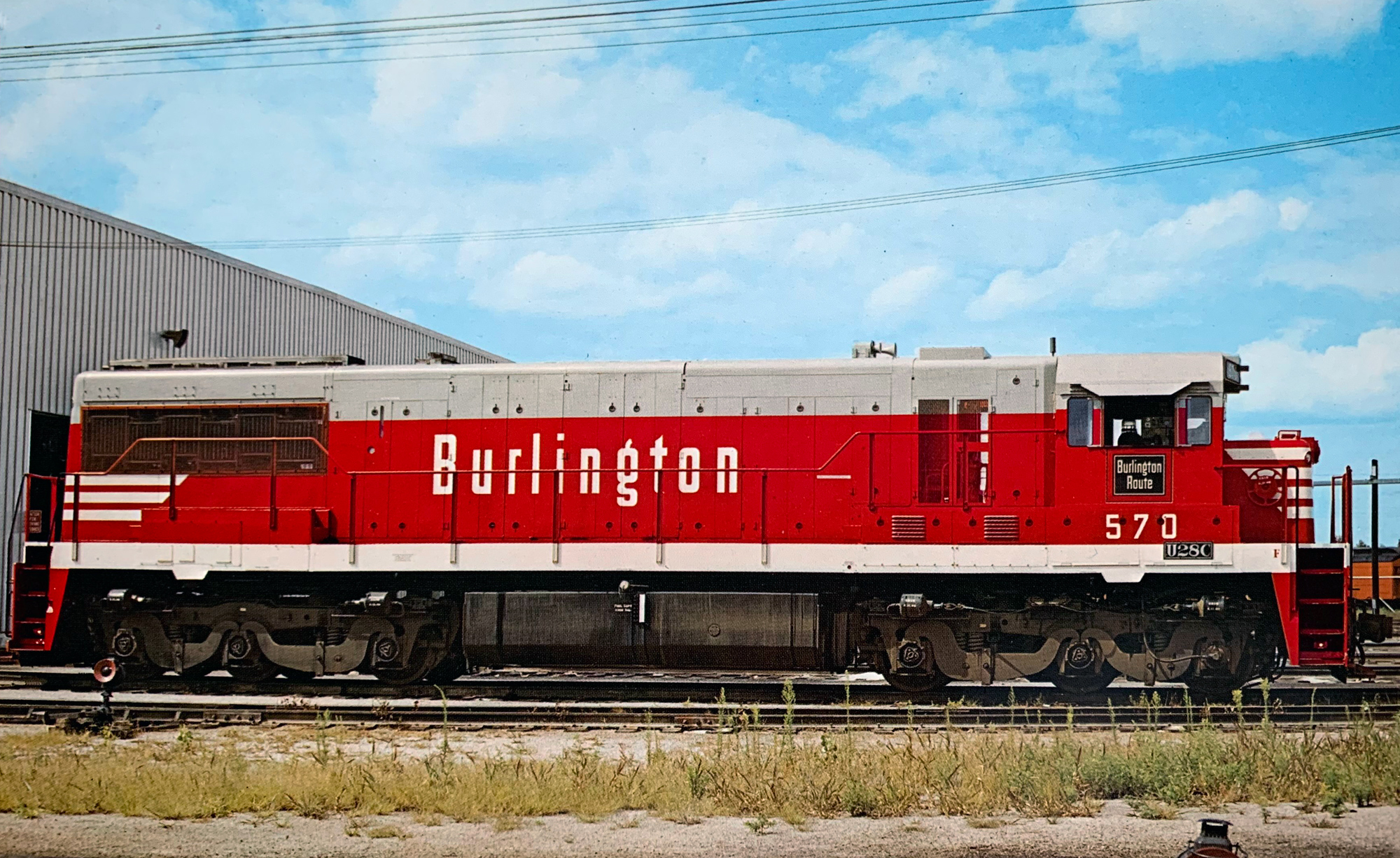GE "U28C" and "U28CG" Locomotives: Specs, Roster, History
Last revised: January 1, 2025
By: Adam Burns
The U28C was General Electric's second six-axle model and virtually identical to its predecessor (U25C) save for a slight
increase in horsepower.
When the U28C was cataloged many roads were still not embracing high-horsepower, six-axle models. As a result, this particular model witnessed few sales.
There was also a variant, the U28CG, a duel-service designed equipped with a steam generator for passenger service. Only the Santa Fe purchased this model.
During the late era of privately-operated rail travel, several railroads turned to duel-service road-switchers that could be used in both freight and passenger applications.
In essence, the U28C was never intended to enjoy a long production run. At the time, all three builders were working towards a 3,000 horsepower road-switcher and offered 2,800 horsepower models in the interim.
When GE released the later U30C, U33C, and U36C the builder sold more than 1,000 examples of these models.
Today, one U28C is preserved; Union Pacific #2804 is on display at the National Transportation Museum in St. Louis retaining its original number and colors.
Photos
 Santa Fe U28CG #350 with train #23, the westbound "Grand Canyon," stopped at Chillicothe, Illinois; circa 1968. American-Rails.com collection.
Santa Fe U28CG #350 with train #23, the westbound "Grand Canyon," stopped at Chillicothe, Illinois; circa 1968. American-Rails.com collection.Overview
The U28C was not really a stand-alone model but merely a transition variant from the U25C. As GE continued external improvements it was able to increase the horsepower rating of its standard 7FDL16 prime mover.
As a result, a few late-era U25C's, notably Atlantic Coast Line #3011-3013, were uprated to 2,800 horsepower which ushered in the U28C.
This was all thanks to major electrical upgrades. As Brian Solomon notes in his book, "GE Locomotives," the builder switched to an AC-DC transmission system. He goes on to note:
"The new system used an alternator rather than a generator and employed silicon diodes to rectify alternating current to the direct current needed by traction motors.
This reduced the number of components, decreased maintenance, and, most significantly, allowed for higher output to traction motors."
All the common attributes of early GE locomotives were present in the U28C such as a boxy carbody, low nose, and simple design.
 A trio of Santa Fe U28CG's await departure from Chicago's Dearborn Station with train #15, the southbound/westbound "Texas Chief," on October 11, 1970. American-Rails.com collection.
A trio of Santa Fe U28CG's await departure from Chicago's Dearborn Station with train #15, the southbound/westbound "Texas Chief," on October 11, 1970. American-Rails.com collection.Its tractive effort was slightly higher than the earlier U25C at 92,500 pounds of starting and 79,500 pounds continuous. Interestingly, General Electric had offered its earlier U25 model with an optional steam generator for passenger service. However, there were no buyers until the U28's release.
Santa Fe saw interest in the variant as a duel service locomotive and liked its increased horsepower. Aside from its steam generator and faster gearing (enabling it to reach speeds over 90 mph), the U28CG was identical to it counterpart.
Data Sheet
| Entered Production | 2/1966 (Chicago, Burlington & Quincy #562) |
| Years Produced | 2/1966 - 11/1966 |
| GE Class | U28C |
| Engine | 7FDL16 (16 cylinder) |
| Engine Builder | General Electric |
| Horsepower | 2800 |
| RPM | 1050 |
| Length | 64' 6" |
| Height (Top Of Rail To Top Of Cab) | 14' 7" |
| Width | 9' 11" |
| Weight | 395,500 Lbs |
| Fuel Capacity | 3,000 Gallons (U28CG 2,200 Gallons) |
| Air Compressor | 3CDC (Westinghouse) |
| Air Brake Schedule | 26L (Westinghouse) |
| Steam Generator (U28CG) | 800 Gallons |
| Trucks | C-C |
| Truck Type | Trimount/Adirondack |
| Truck Wheelbase | 13' 0" |
| Wheel Size | 40" |
| Traction Motors | 752 (6), GE |
| Traction Generator | GT598, GE |
| Auxiliary Generator | GY27, GE |
| MU (Multiple-Unit) | Yes |
| Dynamic Brakes | Optional |
| Gear Ratio (U28C) | 74:18 |
| Tractive Effort/Starting (U28C) | 92,000 Lbs |
| Tractive Effort/Continuous (U28C) | 79,500 Lbs at 10.7 mph |
| Top Speed (U28C) | 70 mph |
| Gear Ratio (U28CG) | 77:26 |
| Tractive Effort/Starting (U28CG) | 98,875 Lbs |
| Tractive Effort/Continuous (U28CG) | 75,000 Lbs at 10.7 mph |
| Top Speed (U28CG) | 93 mph |
Production Roster
| Owner | Road Number | Serial Number | Order Number | Completion Date | Quantity |
|---|---|---|---|---|---|
| Northern Pacific | 2800-2801* | 35630-35631 | 1815 | 4/1966 | 2 |
| Chicago, Burlington & Quincy | 562-571* | 35751-35760 | 1816 | 2/1966-3/1966 | 10 |
| Chicago, Burlington & Quincy | 572-577* | 35815-35820 | 1816 | 4/1966 | 6 |
| Northern Pacific | 2802-2811* | 35882-35891 | 1815 | 4/1966-5/1966 | 10 |
| Louisville & Nashville | 1525-1532 | 35892-35899 | 1908 | 5/1966-6/1966 | 8 |
| Santa Fe | 350-359 (U28CG)** | 35993-36002 | 1990 | 7/1966-8/1966 | 10 |
| Union Pacific | 2800-2804 | 36014-36018 | 1915 | 6/1966 | 5 |
| Pennsylvania | 6520-6525 | 36019-36024 | 1912 | 9/1966 | 6 |
| Pennsylvania | 6526-6527 | 36026-36027 | 1912 | 9/1966 | 2 |
| Pennsylvania | 6528 | 36025 | 1912 | 9/1966 | 1 |
| Pennsylvania | 6529-6534 | 36028-36033 | 1912 | 9/1966 | 6 |
| Union Pacific | 2805-2809 | 36063-36067 | 1917 | 8/1966-9/1966 | 5 |
| Southern Pacific | 7150-7159 | 36068-36077 | 1916 | 10/1966-11/1966 | 10 |
* Equipped with the U25C carbody.
** Equipped with steam generators for passenger service.
Sources
- Foster, Gerald. A Field Guide To Trains. New York: Houghton Mifflin, 1996.
- Marre, Louis A. Diesel Locomotives: The First 50 Years, A Guide To Diesels Built Before 1972. Milwaukee: Kalmbach Publishing Company, 1995.
- McDonnell, Greg. U-boats. Toronto: Stoddart Publishing, 1994.
- Pinkepank, Jerry A. Diesel Spotter's Guide. Milwaukee: Kalmbach Publishing Company, 1967.
- Solomon, Brian. GE Locomotives: 110 Years Of General Electric Motive Power. St. Paul: MBI Publishing, 2003.
 A new Chicago, Burlington & Quincy U28C, #570, is seen here in the spring of 1966. This unit later became Burlington Northern #5658. Author's collection.
A new Chicago, Burlington & Quincy U28C, #570, is seen here in the spring of 1966. This unit later became Burlington Northern #5658. Author's collection.Reception
From a historical perspective, GE is often lauded for its Universal line, which eventually allowed the builder to overtake Electro-Motive in locomotive production by the 1980's. However, most crews who operated U-boats were not fond of the locomotives, often describing them as "junk."
In addition, Electro-Motive models released in the same period can still be found in revenue service throughout the country while nearly all U-boats now are either scrapped or reside in museums.
For the Santa Fe, issues with its U28CG force the railroad to reassign its ten to freight service where they remained until their retirement in 1980.
For the Class Is which purchased the standard U28C, most had retried theirs by the 1980s. By then, GE was offering more powerful and reliable models such as the Dash 7 series and early Dash 8 designs.
Recent Articles
-
Minnesota Railroad Museums: A Complete Guide
Apr 22, 25 12:17 PM
The state of Minnesota has always played an important role with the railroad industry, from major cities to agriculture. Today, several museums can be found throughout the state. -
Massachusetts Railroad Museums: A Complete Guide
Apr 21, 25 11:41 PM
There are a handful of museums located in the state of Massachusetts detailing its long and storied history with trains, which can be traced back to the industry's earliest days. -
Maryland Railroad Museums: A Complete Guide
Apr 21, 25 01:36 PM
The state of Maryland is where it all began with the Baltimore & Ohio. Along with the B&O Railroad Museum, several other similar organizations can be found in the state.